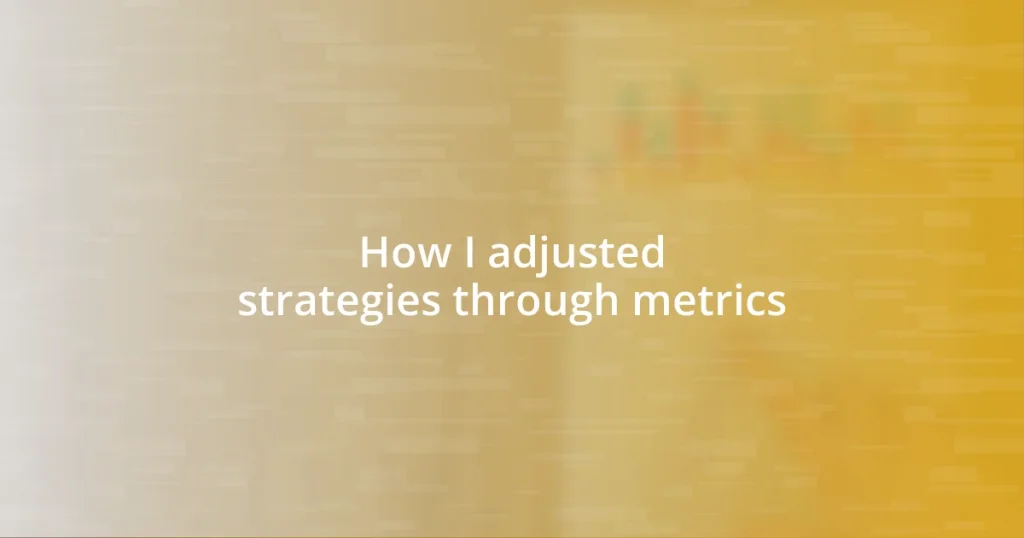Key takeaways:
- Metrics are essential for guiding strategies; collecting and analyzing data transforms vague feelings of success into actionable insights.
- Identifying effective KPIs involves aligning them with goals, prioritizing actionable insights, and engaging the team in discussions.
- Continuously refining metrics and strategies fosters collaboration and a culture of improvement, leading to meaningful adjustments and enhanced outcomes.

Understanding the role of metrics
Metrics play a crucial role in shaping effective strategies. I can still recall a time when I was managing a project and decided to track specific performance indicators. As I did this, I became acutely aware of the patterns that emerged, which led me to pivot my approach significantly. Isn’t it interesting how numbers can tell a story we might otherwise overlook?
When I first started incorporating metrics into my decision-making, it felt a bit like diving into the deep end of a pool. I was uncertain and intimidated, but as I waded through the data, I discovered invaluable insights. This process transformed vague feelings of success into concrete evidence, illuminating areas for improvement I hadn’t even considered.
A key aspect of metrics is their ability to provide clarity and direction. Have you ever been overwhelmed by too many choices and unsure which path to take? Metrics can cut through that noise, guiding decisions like a lighthouse in the fog. Reflecting on my experiences, I’ve learned that having a data-centric mindset not only drives strategy but also boosts confidence in the choices we make.

Identifying key performance indicators
Identifying the right key performance indicators (KPIs) can feel like looking for a needle in a haystack at times. In my experience, it took a bit of trial and error to hone in on metrics that truly reflected the health and progress of my initiatives. I remember initially focusing on vanity metrics, like social media likes, which made me feel good but didn’t contribute to our actual goals. It’s fascinating how real KPIs can shift your perspective, bringing focus where it’s needed most.
To identify effective KPIs for your projects, consider the following:
- Align KPIs with your specific goals and objectives.
- Prioritize metrics that provide actionable insights rather than just numerical data.
- Regularly revisit and adjust the KPIs based on evolving strategies and outcomes.
- Engage your team in discussions about what indicators matter most to them.
- Ensure the KPIs are measurable and can be tracked effectively over time.
By reflecting critically on the data that matters, I found it easier to steer my projects in a direction that genuinely aligned with my intended outcomes. It was enlightening to discover that the right metrics not only guide decisions but also create a shared vision, fostering collaboration within my team.

Collecting data for analysis
Collecting data for analysis is a vital step in refining strategies. In my own journey, I often felt overwhelmed by the sheer volume of data available. I remember a project where I was knee-deep in spreadsheets, trying to make sense of what really mattered. It turned out that focusing on qualitative data, like customer feedback, paired with quantitative metrics, provided a well-rounded perspective. Just think about it—numbers can paint a picture, but stories breathe life into them.
Another pivotal moment for me was when I learned the importance of systematic data collection methods. Initially, I relied on whatever data was readily available, which sometimes resulted in inconsistencies and confusion. Implementing structured processes, such as regular surveys and tracking tools, significantly improved the quality of information I gathered. This shift made a world of difference; I was no longer fishing in the dark but rather building a foundation of reliable insights that could support decision-making.
As I navigated this data-centric world, I discovered that visualization tools became my allies. They transformed complex data sets into digestible graphics that made trends and patterns apparent at a glance. I vividly recall creating a dashboard that displayed key metrics in real-time. The excitement I felt as I could monitor progress instantly was exhilarating! It truly reinforced my belief that effective data collection isn’t just about numbers—it’s about creating a narrative that helps make informed decisions.
| Data Collection Method | Description |
|---|---|
| Surveys | Gathering qualitative insights directly from users or team members. |
| Tracking Tools | Utilizing software to monitor performance metrics over time. |
| Visualization Tools | Creating graphic representations of data to reveal trends quickly. |

Interpreting metrics for actionable insights
To truly interpret metrics for actionable insights, I’ve found that context is everything. One time, while dissecting website traffic data, I noticed a spike during a specific campaign period but failed to correlate it with conversion rates. This disconnect made me wonder—was all that traffic meaningful if it didn’t translate into action? By looking deeper into the data and aligning it with the broader objectives, I could clarify the story it was telling. Suddenly, those numbers transformed from mere figures into a roadmap for future campaigns.
A pivotal moment for me was when I began asking myself what each metric actually meant for my strategy. For instance, tracking engagement on an email campaign felt great until I realized many clicks were leading to a dead end. I remember feeling frustrated but then shifted my perspective to see it as an opportunity. Adjusting my content based on that insight not only enhanced the quality of engagement but also improved conversions. It’s incredible how interpretation can pivot from viewing metrics as just numbers to recognizing their potential to drive significant change.
I’ve also learned that the collaboration aspect is crucial in interpreting metrics. Sharing findings with my team has led to richer discussions and diverse viewpoints, often uncovering insights I might have overlooked alone. For instance, when we reviewed customer satisfaction scores, different departments provided unique interpretations based on their interactions with clients. This collaborative approach not only deepened my understanding but fostered a collective ownership of our metrics. Have you experienced that moment when a seemingly mundane number suddenly sparks a lively debate? Those moments are gold—they reinforce the idea that metrics are more than just data; they’re a conversation starter that can guide strategic action.

Adjusting strategies based on findings
Adjusting strategies based on findings can be a game-changer. I remember a particular instance during a product launch when user engagement metrics showed a concerning drop-off rate. Instead of brushing it off, I gathered the team and we dove into the analytics. It was enlightening to pinpoint that the onboarding process was overly complicated, and by simplifying it, we transformed a frustrating experience into one that felt more welcoming for users. Isn’t it fascinating how sometimes, a small tweak can cascade into a significant improvement?
As I refined our strategies, I realized that flexibility is key. After analyzing customer feedback, I once encountered a recurring theme: users craved more personalized content. I’ll never forget the moment I decided to pivot our marketing approach. It was like a light bulb went on! We transformed our messaging and met that need head-on, and not only did our engagement improve, but the connection with our audience deepened. Have you ever felt hesitant about making changes but found immense rewards afterward? That’s the beauty of adapting your strategies based on real findings.
I’ve also discovered that testing adjustments is critical. After updating our social media strategy based on the latest trends, I initiated A/B testing on different content types. The thrill of seeing which version resonated more with our audience was addictive! It became clear that data isn’t just a static reference; it evolves as we learn and adjust our tactics. Isn’t it rewarding to witness numbers shift in response to thoughtful changes? This iterative process not only boosts confidence but cultivates a more dynamic approach to strategy.

Implementing changes and tracking impact
Implementing changes based on the insights from metrics is where the real magic happens. I can recall a time when we adjusted our ad placements after noticing they weren’t performing as expected. Instead of just switching things up randomly, we took a closer look at our target audience’s online behavior. The relief I felt when we finally saw a boost in engagement was palpable. It’s incredible to see how thoughtful adjustments can create ripples of improvement, right?
Tracking the impact of those changes is where the learning journey continues. I once invested in a new customer feedback tool after a campaign revamp, curious about its effectiveness. The first set of responses felt like opening a treasure chest—each comment guided us further toward understanding what was truly resonating with our audience. Have you ever felt that thrill when feedback aligns perfectly with your expectations? It’s one of those rewarding moments that really emphasize the importance of measuring impact.
To be honest, it’s not always a smooth ride. I’ve faced moments of doubt, especially when initial results rose and dipped unpredictably after implementing changes. It’s like holding your breath during a roller coaster ride. But I learned to embrace those fluctuations as part of the learning process. Each new metric teaches us something, even if it’s not what we wanted to hear. Isn’t it fascinating how sometimes the toughest lessons become the foundation for our next successes?

Continuously refining metrics and strategies
Refining metrics and strategies is an ongoing journey for me. One time, we noticed a subtle shift in user preferences through our analytics; it was like a whisper nudging us in a new direction. I took a step back and scrutinized these insights. By adjusting our content calendar based on this new data, we ended up aligning our offerings more closely with what our audience truly wanted. Have you ever felt that exhilarating rush when you realize you’re on the right track just in time?
In my experience, the process of refining strategies often feels like solving a complex puzzle. There was a project where we aimed to boost email open rates. Initially, we relied heavily on standard subject lines, but an analysis revealed that personalization was key. After experimenting with dynamic subject lines that reflected user interests, we saw a tremendous leap in engagement. It reminded me how crucial it is to iterate and test; without that, we might just be shooting in the dark. Isn’t it refreshing to see how minor adjustments can dramatically shift our outcomes?
Nurturing a culture of continuous improvement within a team is something I strongly advocate. I remember encouraging my colleagues to embrace a “fail fast, learn faster” mentality when it came to trying new strategies. When one of our latest campaigns didn’t perform as expected, instead of despair, we gathered insights together, dissected what went wrong, and brainstormed improvements. This collective experience not only strengthened our bond but reinforced the notion that every metric carries a lesson. Isn’t it empowering to realize that every setback can lead to a more refined approach?















